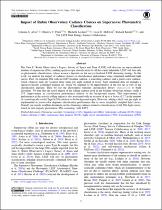| dc.description.abstract | The Vera C. Rubin Observatory’s Legacy Survey of Space and Time (LSST) will discover an unprecedented
number of supernovae (SNe), making spectroscopic classification for all the events infeasible. LSST will thus rely
on photometric classification, whose accuracy depends on the not-yet-finalized LSST observing strategy. In this
work, we analyze the impact of cadence choices on classification performance using simulated multiband light
curves. First, we simulate SNe with an LSST baseline cadence, a nonrolling cadence, and a presto-color cadence,
which observes each sky location three times per night instead of twice. Each simulated data set includes a
spectroscopically confirmed training set, which we augment to be representative of the test set as part of the
classification pipeline. Then we use the photometric transient classification library snmachine to build
classifiers. We find that the active region of the rolling cadence used in the baseline observing strategy yields a
25% improvement in classification performance relative to the background region. This improvement in
performance in the actively rolling region is also associated with an increase of up to a factor of 2.7 in the number
of cosmologically useful Type Ia SNe relative to the background region. However, adding a third visit per night as
implemented in presto-color degrades classification performance due to more irregularly sampled light curves.
Overall, our results establish desiderata on the observing cadence related to classification of full SNe light curves,
which in turn impacts photometric SNe cosmology with LSST. | en_US |

